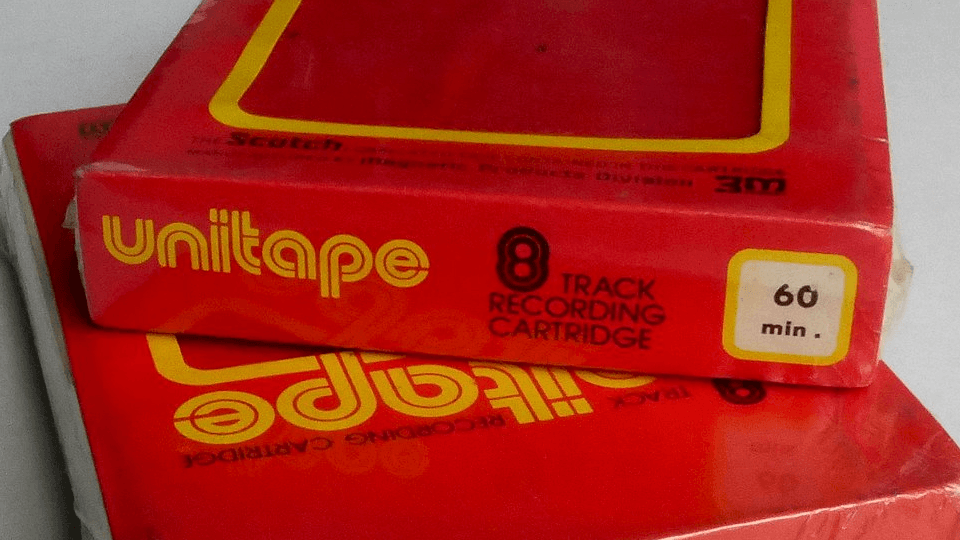8-track tape. Wait: 8-track? For a generation that’s been streaming, downloading (and by nostalgic turns, purchasing vinyl), the 8-track tape is a Jurassic-era piece of technology that thankfully went the way of the floppy disc.
In the meantime, the humorous slant that one of a certain age associates with 8-track is altogether warranted. Envisioned as a replacement to the elite few who installed record players in their pricey automobiles in the 1960s – yes, we’re talking about you, Paul McCartney – the 8-track was pitched as the savior of portable music. Rugged. Unskippable. No warping… but more on those claims later.
As far back as the realization of what 8-track promised and its less-than-glorious downturn, it’s about time it had a resurgence for the masses. As recently as 2020, Dolly Parton released A Holly Dolly Christmas on 8-track. The format it appears isn’t quite in the grave, but what started this revolution into how your vehicle became the soundtrack to your childhood?
An inferior 4-track version (initially marketed as more of a dictaphone tape) was the jumping point to 8-track, mainly because the upgraded pinch roller was incorporated into the cartridge mechanism. It was a closed-loop system, meaning you didn’t have to manually ‘flip’ over the tape: the mechanics of the player head allowed it to jump to the next track.
All of this sounded out-of-this-world back in the early ‘60s and the inventor himself (Bill Lear of LearJet fame) had the clout to bring the technology into the booming automotive market.
Lear was actually more than aviation. He helped build the first car radio and with that process, he locked into a consortium by way of his association with Motorola to get that company’s alliance with Ford into a deal for 8-track players that could be factory-installed in 1966 Mustang, Lincoln, and Thunderbird models. This process, coupled with RCA introducing the cartridges by way of their artist roster was the sweet icing on the dashboard cake.
The popularity of bringing music into your car without the gaggle of chatter, jingles, and hi-jinks that was the bane of AM radio, pushed all the right buttons with consumers. It wasn’t long before home components were being manufactured, adding another layer to the listening experience.
And portable players were right behind. In the early ‘70s, Panasonic introduced what was advertised as the ‘Dynamite 8,’ a colorful on-the-go 8-track player that looked like Wile E. Coyote’s detonator. And as the demand grew during that era, US soldiers in Vietnam used a version with batteries, as the system was beloved for its sound and ruggedness. Soon, the 8-track was overtaking vinyl as the go-to for high-fidelity output, and its listing for artists ran all the way from top-sellers (Iron Butterfly, The Beatles, Credence Clearwater Revival, Blood, Sweat & Tears) to the sensory overload of Realistic’s Sound Effects In Stereo. But as someone said, for the 8-track to become iconic, it had to die.
As the technology advanced, so did magnetic tape capabilities and the quality of the cartridge. While it was great to have infinite looping, it also became frustrating to have the song ‘interrupted’ by the changing of the track (remember that familiar clunking sound?) or the gradual decrease in quality in the magnetic tape as it was played endlessly.
The claims of being indestructible were slightly exaggerated: the label would peel and pucker and the tapes could break apart if mishandled. What was the solution? The cassette.
Smaller, lighter, portable, and with greater recording capacity, this format was nipping at the heels of the 8-track. And soon enough, the cassette was the choice for the auto, home, beach, and more. The introduction of the Sony Walkman in 1979 had 8-tracks skipping towards a cliff.
Yet, the diehards remain among us. The 1995 documentary So Wrong, They’re Right looked and sounded painfully cheesy yet showed the devotion and stalwart support among the legion of audiophile 8-track geeks that continued to convert the naysayers and preach the legacy of a nearly-defunct, flawed listening legacy.
You can still buy tapes and players today. Some are fake (a Beatles “Butcher Cover” that was never produced), some are worth a pretty penny (Sinatra Jobim can fetch $4200) and some titles will never die (Pink Floyd’s Dark Side Of The Moon).
So, fear not dear connoisseurs of the 8-track. The best technology in the world can’t keep this dinosaur from extinction.
-Amy Hughes
Photo: Erkaha via Wikimedia Commons





The 8-track tape in quadraphonic is a sub-niche. But it is really awesome to listen to 4 distinct sounds. Provides a unique perspective to listening to some of our favorite artists/songs of the era.
I’d completely forgotten the quadraphonic version. I believe I actually owned the 8-track of the Who’s “Quadrophenia”. I actually saw them perform that live in quadraphonic sound.
I would have guessed you had a Quadrophenia 8 track. Loved dancing with you to The Stones, a long time ago, but one of my most loved memories.